
20 March 2019.
The houses are lined along the shore like soldiers, creating an organic seam that joins the sea with the forest-covered hills immediately behind them. They sit on stilts above the water, each two stories high with living quarters above and workspace and a boat garage at water level. They are Funaya, the traditional wooden boathouses of the village of Ine, tucked into well-protected Ine Bay on the north-eastern corner of Tango Peninsula. There are 230 Funayas, some having existed since the 1700’s.
But first we had to get there.
When I went to Japan in 2018, travelling solo, I’d hoped to make the trip to Ine from Kyoto, but I lost a day to rain, and another to exhaustion so with a tight schedule I ran out of time. Truth be told I was intimidated by the journey. Although details are available online it sounded long and complicated.
In the end it was all so simple.
Come with me on a journey from Kyoto to the unique fishing village of Ine and the boathouses of Ine Bay.
On a mild sunny day we set out from our Airbnb machiya in the Gion neighbourhood and make our way to Kyoto Station where we board a train to Amanohashidate. We make sure to get the “limited express” so we won’t have to change trains. Scenes of rural Japan flow by as I gaze out the window on this two-hour journey. There’s a valley completely submerged by cloud, a long low cloud that goes on and on so that all that is visible are the fields and villages in front of it and the mountains behind. The cloud has descended to earth not as mist or rain, but as cloud itself kissing the land. And then as we head further north towards the coast and the day warms up we see villages and mountains.
Finally we arrive at Amanohashidate and head into the tourist office. It is Japan. Of course there is a tourist information office at the station. And of course there are kind helpful people there who can tell you all you need to know. Having previously researched the activities available in Amanohashidate we decide on walking the sandbar. We choose not to take the chair lift or cable car to the viewing point, considered one of the three most famous views in Japan,

as our hearts are set on getting to Ine Bay and there’s not time for both.
Everything from our research is confirmed at the tourist office: walk the sandbar, at the far end take a bus to Ine, get off at the cruise dock, after the cruise walk into the village and take the bus all the way back to Amanohashidate Station. I always worry about finding bus stops, and knowing when to get off the bus, and how will I know when I get there? But it is all so obvious and easy. It is Japan after all. The Japanese are nothing if not organised. And helpful. They shepherd us every step of the way.
Walking the sandbar, which is said to have appeared like a floating bridge from heaven, a gift from the gods that gave Amanohashidate its name, is a dream: a gentle 4 kilometre stroll of about an hour. There are others around us either walking or cycling, families out for the day, and fellow tourists, but it is never crowded.
We are surrounded by a luminous beauty. There are eight thousand pine trees on the sand bar.
On one side is Asokai Lagoon,
and on the other Miyazu Bay, edged by curve after curve of creamy sand beaches carpeted with pine needles.

Feel the soft gravelly dirt crunching underfoot, see the play of light and shadow as the sun dances with the trees. Duck under the low branches to see the beaches on one side
and the lagoon on the other.
On we stroll past a fresh water spring known as Isoshimizu and dressed as a temple, the occasional concession stand, a small shrine, picnic benches, and ancient trees lovingly propped up with tall poles,
until we are almost at the end and sit for a rest and a snack while facing the tranquil waters of the lagoon.
From here we soon reach the road and take a quick look at Motoise Kono Shrine

but only a quick look because we don’t want to miss the bus.
It is a one-hour bus ride along by the water north of Miyazu Bay
and through a village
to the cruise boat dock at the edge of Ine Bay. The bus driver wears a uniform with a peaked hat and white gloves.
All the bus drivers we see in Japan are dressed like this. The routine there is to use the rear door to get on the bus and the front door to get off. As you get off the bus driver thanks every passenger. Every one. Arigatō gozaimashita he will say, over and over like a chant, a ritual of courtesy.
We have no trouble knowing when to get off the bus. No doubt the bus driver knows that almost everyone wants to get off at the cruise boat dock, and as soon as we arrive there are others to guide us to the boats.
And now we are out in Ine Bay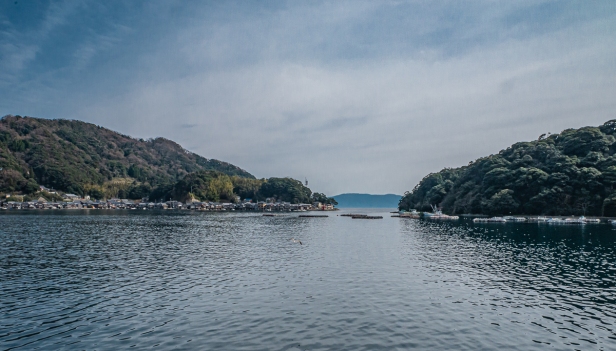
standing on the open deck of the boat, and people with birdseed are holding their hands high and the eagle hawks come diving in, so close I can almost touch them.
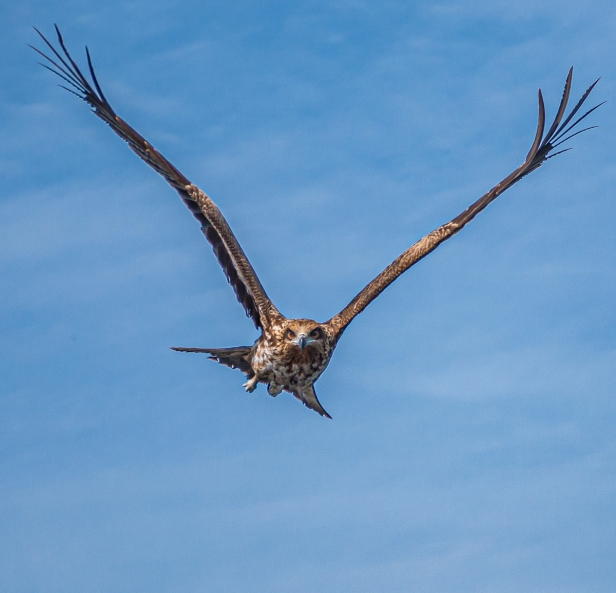
Soon too the seagulls join in and the boat is surrounded by birds that accompany us for much of the nearly one-hour voyage around the bay.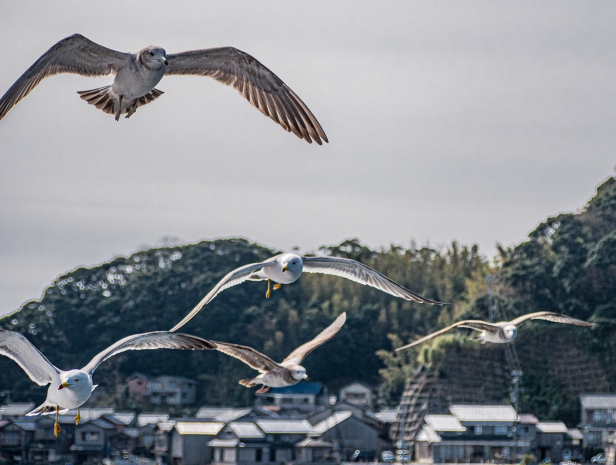

Ine Bay, on the north-eastern edge of Tango Peninsula, hooks around and faces south, and is almost completely enclosed, protecting it from storms, tidal movement, and sea swells. People have gathered here for the rich fishing grounds and the safety of the harbour for 1400 years. In this perfect location for fishing the people devised houses perfectly suited to the location. With little flat land available, and not wanting to disturb the forest, which for centuries was believed to sing to the fish with the gentle rustling of leaves, they built their houses on stilts over the water at the foot of the mountains, with space for boat mooring underneath. With their backs to the revered fish-serenading forests the homes of the people face the water that brings their livelihood.


And so it is still today. The people of Ine have faithfully guarded their way of life. The village, of about 2000, exists in a symbiotic relationship with the sea, and there is a conscious effort by the community to preserve their unique way of life. Fishing is considered a community activity, and the day’s catch is offered first to the people of the village.
After cruising around the bay from one side to the other, hugging close the edge where possible, moving slowly past the Funaya, we eventually return to the dock in plenty of time to explore the village from the landside.
We are nosy. Well I am nosy. I want to see everything. I try to do it without being obnoxious. We come across a huge paved shelf, a dock of sorts where a group of fishermen are hunkered down on the ground mending their nets. So many nets! Those that notice us wave. They are engaged in their work, all involved together as one entity. There is an air of purpose and contentment. There is no hint of competition or ownership here. Each contributes for the good of all, for the community.

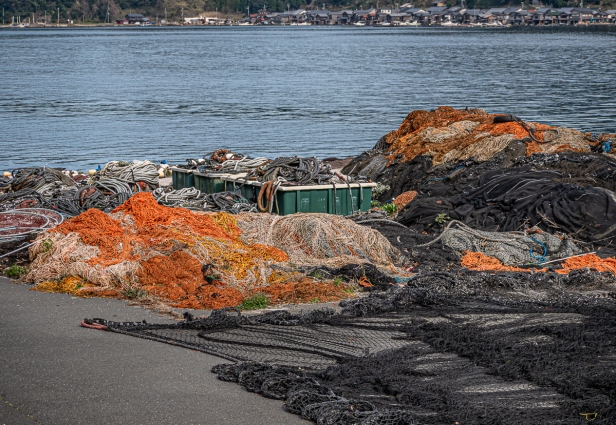
Wandering on down the curved road
we peer down mysterious alleys running between the Funaya.
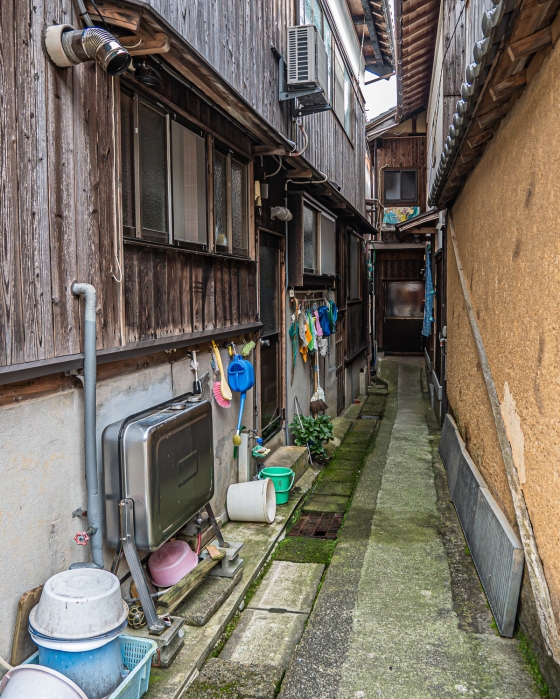

Each gives hints of ordinary life: a bicycle, mops and buckets, a watering can, brooms, dish rags, plastic tubs, hoses and ropes curled like snakes. And we get glimpses into the boat garages that tell tales of a life spent in symbiosis with the sea.

All is neat and orderly. A feeling of calm serenity pervades even these spaces.
We peer in the window of the bottling plant of the Mukai Shuzo Sake Brewery, which has been distilling sake here since 1754
On the landside of the street there are houses and storage spaces built since the 1930’s when a road was put in, all of them devotedly adhering to the same style as the original Funaya.
In an open space where we wait for the bus we get a closer look at the fronts of the houses, hung with laundry and seaweed drying in the sun,
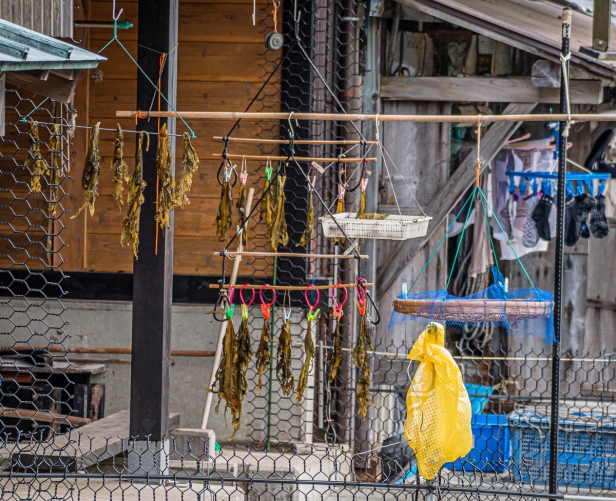
and one last look out to Ine Bay,
the idyllic land and sea combination that first attracted people to make their homes here 1400 years ago and still holds the community in thrall today. So much has changed over those centuries, but still this little village and the infinite sea have endured in all that really matters.
Next post: perhaps something about our trip to Malaysian Borneo. Or a beautiful prayer ritual to the Ganges.
All words and images by Alison Louise Armstrong unless otherwise noted
© Alison Louise Armstrong and Adventures in Wonderland – a pilgrimage of the heart, 2010-2020.

The photos are taking me gently there. I have to say, I have always been quite curious about rural Japan (overcrowded cities seem a bit too overwhelming). I can almost smell the salty air and hear the quiet waves.
What a journey, thank you, Alison,
❤
LikeLiked by 1 person
Thank you Anyes, and you’re welcome. I’m glad you came on this gentle journey with us. It was so lovely there. Rural Japan is quite lovely – lots of power lines and such, but there are pockets of great beauty, and this is one of them.
Alison
LikeLiked by 1 person
You are such a gifted person Alison.
I am trying to convince my family to move to your native home. I like the way Oz is handling everything, from corona to China.
Plus there are the BIRDS! And the space, and the low population density.
LikeLiked by 1 person
Thanks so much Cindy. This was such a special day in Japan.
Re Oz I’m with you on the birds (swoon) and the space, not so much on the govt and their handling of refugees (cruel and heart-breaking) and of the bushfires earlier this year (dismissive and uncaring) among other things.
Oh but the wildlife! I do miss that. And the landscape. Oh and my family 🙂 It’s been 4 years now since I was last there so I’m overdue for a visit.
Alison
LikeLike
Very captivating, I feel like visiting the area already!!great use of words,simple ,easy to understand.
LikeLiked by 1 person
Thank you so much! I’m glad you enjoyed it. This was a really special day in Japan for us, and I’m happy I was able to convey some of that.
Alison
LikeLike
This is just beautiful. I am not minding Corona so much, but this post made me really want to get out there and explore the world again. Fabulous.
LikeLiked by 1 person
Thanks Tracey. We loved this little adventure. When I was researching Japan for my first visit it quickly went on the list. I’m not minding corona too much, especially now I can get out and walk every day.
Alison
LikeLike
Glorious outing. Glad you managed to do it.
LikeLiked by 1 person
Thanks so much Peggy. It was lovely, definitely worth it.
Alison
LikeLike
Love the way you led us into the heart of the place, and amongst its fisher people. ANd those bird shots – marvellous, Alison.
LikeLiked by 1 person
Thanks so much Tish. It really was a lovely day. I was captivated by the village. And those birds coming so close! Such an unexpected highlight.
Alison
LikeLiked by 1 person
What an incredibly interesting post, Kyoto looks fascinating and so full of character. The beaches look fabulous and everything looks so clean.
LikeLiked by 1 person
Thanks so much Jonno. This whole area is in Kyoto Prefecture, though obviously not in the city of Kyoto. We were happy to get out of the city for a day (even though it’s a lovely city). Everything in Japan is clean. Honestly everything. It’s one of the cleanest countries I’ve been to, and one of the reasons I love it so much. I’d love to get back to those beaches in the summer!
Alison
LikeLiked by 2 people
How lovely Alison. Both the photos and your words take me there to wind along the road and narrow alleys and observe a centuries-old way-of-life. Anita
LikeLiked by 1 person
Thanks so much Anita. I’m glad I was able to convey what it was like. It was such a lovely day and I’m really glad we went.
Alison
LikeLike
I wish I had, too, a boat in my driveway and – instead of a road – the open sea! Thanks for the ride Alison, miss Japan and nice little touches like a bus driver in a three-piece suit, white gloves and hat. Standards!!
Fabrizio
LikeLiked by 1 person
You’re welcome. Happy to have you along. I think it would be wonderful to spend more time in this village, in a homestay, and go out on the water in a private boat. One of the ways they’re keeping the village going is through homestays. I think there are 15 of them.
Oh the uniforms in Japan! Love them. Yes – standards!
Alison
LikeLiked by 1 person
Enjoyed the trip to Japan of fishing nets & alleys
LikeLiked by 1 person
Thanks so much Indra. I’m glad you enjoyed it. It was such a lovely and interesting day.
Alison
LikeLiked by 1 person
Ahhh, this was such a nice escape! Loved seeing the traditional homes on the water and the beautiful sandbar. I swear you are the bird whisperer — you always get such amazing photos! I needed this today. Thanks for taking me away. 🙂
LikeLiked by 1 person
Thanks Kelly. I’m so glad this little visit to Japan could take you away for a bit. I just love japan. For many years it didn’t appeal to me at all, then when I finally got there I totally fell in love and would go back in a heartbeat. I watch Japanese soaps on Netflix 🙂
Thanks re the birds – I always think that I just get lucky, but I’ll take your kind compliment for sure 🙂 It was really amazing on the boat when they were coming so close.
Alison
LikeLiked by 2 people
Japanese soaps?! Love it! 🙂
LikeLiked by 1 person
What beautiful captures of this fishing town. Hope you are safe and well.
LikeLiked by 1 person
Thanks so much Atreyee. I found this town so quintessentially Japanese – in all the best ways. The whole excursion nourished my soul.
We are both safe and well and holed up in our little place in Vancouver. Thankfully we can get out for a good hike most days.
Hope you are safe and well too, and not feeling too confined with this new world order we live in now.
Alison
LikeLiked by 1 person
Good to hear! I’m so grateful to be near nature as well and to be healthy. Take care.
LikeLiked by 1 person
I can’t get over how neat and tide everything and everyone looks. Often fishing villages can have a disheveled look about them. Even the fishermen all in their uniform blue overalls. It was interesting to read about the customs on a Japanese bus and the spirit of cooperation among the fishermen. I’m glad you got here on your second attempt. Definitely looks worth the effort. Your photos are eye candy!
LikeLiked by 1 person
Thanks so much Caroline. Japan is without doubt the most neat and tidy country I’ve ever been too. It’s one of the reasons I love it so much. And almost all people who in any way have a position serving the public wear a uniform – usually including hat and gloves. One position was women who bowed people into the elevators that go up to one of the panoramic views of Tokyo. Two elevators each with a woman in front of it dressed immaculately in a tailored uniform complete with hat and gloves. They would shepherd people into the elevators and when full give a deep bow as the doors closed. As Fabrizio said – standards!
I’m so glad I finally got to Ine, and I’m glad you enjoyed the photos.
Alison
LikeLiked by 1 person
Excellent and Interesting Photos and Descriptions Alison! My wife says if we ever decide to travel anywhere crazy, we should hire you as our guide!
LikeLiked by 1 person
Thanks so much Michael, and thank your wife for the wonderful compliment. I love crazy! 🙂
Alison
LikeLiked by 1 person
Such a photogenic bit of the world! And your bird shots are fabulous 🙂 🙂
LikeLiked by 1 person
Thanks so much Jo. It was such a sweet day; I’m glad I finally got there. The birds were for sure one of the highlights!
Alison
LikeLike
What a wonderful gift of nature, the sand bar with a pine forest on it and water on either side! It does look like a dream. What a special place. How great that you went there this time around.
And yes, it’s amazing how organized and helpful the Japanese are. Makes going anywhere a breeze.
Lovely photos. The stilt houses on water remind me of the ones we saw in Cambodia in Seam Riep.
Peta
LikeLiked by 1 person
Thanks Peta. I was so intrigued by the houses – they seemed so organic, so in tune with their purpose and surroundings. We also saw stilt houses near Siem Reap at a place called Prec Toal – and yes the same feeling. These kinds of buildings seem so much less like an invasion of the natural surroundings than a cooperation with it, and I think that’s why I love them. It’s a feeling of symbiosis rather than conquering.
The sandbar was perfect! Such a beautiful place. Initially we weren’t going to walk it, but then we figured out there’d be plenty of time, and it appealed much more than taking the cable car up to the view though no doubt that would have been lovely too.
I do love Japan for its organization. I doubt I will ever again feel intimidated about going anywhere there. Infrastructure, organization, and helpful people. It makes it all such a breeze.
Alison
LikeLike
It’s funny, but i often feel intimidated by the directions I read before a trip on how to get somewhere or do something, and then when I get there and just jump in, it usually goes just fine. It does help to have a second brain working on logistics (although that can also turn into a nice little argument – haha).
This would be a dream outing for me in so many ways. The walk in on the sandbar, the neat-as-a-pin town, those close-up birds (wow!), the water, the fishermen, and the wonderful politeness and helpfulness that have disappeared in so many other places nowadays. I’m finding it hard to get motivated to read posts on general travel these days for some reason, but once I get going, I am so glad I escaped the circumscribed world in which we are now living. Thank you for today’s outing!
LikeLiked by 1 person
I’m not sure I’ll ever feel completely confident going somewhere new (except in Japan as I said to Peta), and will gather all the info I possible can, but still jump in anyway. And yeah, I appreciate the second brain for logistics and yeah sometimes arguments arise 🙂 though less and less over the years.
It was a *wonderful* day. I’m so glad we went. I love Japan for so many reasons, one being their inherent neatness. It’s funny that two of my favourite countries are India and Japan and they couldn’t be more opposite!
I’m glad you enjoyed today’s outing. Travel posts are better than the news that’s for sure 🙂
Alison
LikeLiked by 1 person
What a beautiful place to have visited. Quite different from the normal Kyoto fare. The photographs of the birds are amazing, you were lucky to get so close.
Lieve
LikeLiked by 1 person
Thanks so much Lieve. The whole thing with the birds was so exciting; to see them so close and to be able to get some good shots of them. It was definitely a highlight. And it was so lovely to see the sand bar and the village. Tourists were well catered for, but it was a long way from tourist central in Kyoto. I always love to get out of the cities.
Alison
LikeLiked by 1 person
Looking at these photos I feel as if I was staying there right now. Awesome!
LikeLiked by 1 person
Thank you so much! That’s the best compliment.
Alison
LikeLike
What’s really amazing is that even in a small village like Ine, people’s houses are just as neat and tidy as those in big cities. I guess this is a testament to Japanese culture which puts emphasis on orderliness. I often think of Japan whenever I’m frustrated by how chaotic things can be in Indonesia — it would be nice to live in Japan, or so I thought. But then thinking of the long hours many Japanese spend at work usually brings my wandering mind back home. I love how bright and vibrant this part of Japan is!
LikeLiked by 1 person
One of the reasons I love Japan so much is because of the neatness and cleanness. It’s a shock to find anything messy there. On the other hand I love India too, which is the opposite of Japan. I imagine Indonesia, especially Jakarta, has some of India’s messiness. It can get frustrating, but also can be really invigorating. From what I know about you I can’t imagine you living in Japan. And yeah, apparently the work hours are pretty brutal.
Alison
LikeLiked by 1 person
Aahhh. Beautiful, Alison. I’ve been gone too long! I love this village that mixes something over a thousand years old with the modern equipment like the bottling equipment, the rubber boots and gloves of the fisherman. It’s all sort of surreal, but just to witness some beauty here, and see people living simply, and for one another as you described it, is incredibly heartening… And I LOVE the notion of the trees whispering to the fish. Who can argue with that!?
Blessings
Michael
LikeLiked by 1 person
Thank you so much Michael. This is exactly the reaction I was hoping for. The world has changed, but is still filled with good people living simple lives. I especially like the way small communities generally take care of each other. I lived in a tiny village (500 people) in Canada’s far northwest for many years and that community feeling of taking care of each other was very strong.
Re the trees – it was discovered that there is a scientific reason for them attracting fish – apparently their existence brings minerals to the soil that leach into the sea and then creates nourishing food for the fish. Those fishing grounds are still fished in a sustainable way and they take out over 3000 tons of fish per year. To me is is a beautiful heartening story of how to have a rich prosperous life and take care of the planet at the same time. May we all learn something about this from our current situation.
Alison
LikeLike
I love that you seek out the less-known places and make the effort to understand them. And once again, you peeked down the alleys to see ordinary life. 🙂 The eagle hawks – amazing captures!! The boats, the traditions, the nets, the forest behind the houses – it’s all wonderful. Thanks for helping us get away. 🙂
LikeLiked by 1 person
Thanks so much Lynn. The birds were definitely a bonus that day. They came so close! I’m glad you enjoyed this trip into another world. It was sooo peaceful there. That village has something special.
Alison
LikeLike
Wow! Fantastic pics, as always. That sandbar looks heavenly – I’m amazed you could pull yourselves away. 🙂
LikeLiked by 1 person
Thanks so much Felicity. The sandbar was pretty lovely, but we were so determined to get to Ine, plus it wasn’t the right time of year for beaching. I’d love to go back on a hot day.
Alison
LikeLike
I’m sad we had to cancel our Japan adventures…it’s a lovely country and I appreciate you showing and telling stories from a rural perspective…we’ll get there yet…lovely captures Alison…smiles Hedy ☺️🤓
LikeLiked by 1 person
Thanks Hedy. Oh I’m so sorry you had to cancel your trip. I do hope you get there one day. Japan is truly special. There’s no place like it and it’s one of my favourite countries.
Alison 🙂
LikeLiked by 1 person
Been once and I was looking forward to some new rural adventures we’ll see if the Olympics happen next year…I agree no place like it…happy Saturday ☀️🤗
LikeLiked by 1 person
I am continually amazed at how, although I’ve lived here well over three years now, there is still so much to see! I’ve never heard of this place, and it looks enchanting. A future trip to daydream about!
LikeLiked by 1 person
Oh I do hope you get there. The whole day was just lovely, and enchanting is the perfect word for Ine. It’s an easy day trip from Kyoto, but if you can stay overnight – some of the funayas have been converted into B&B’s or homestay so you can get a closer experience of their life.
Alison
LikeLiked by 1 person
This is such beautiful post. Excellent and Interesting Photos and Descriptions Alison.
thanks for sharing us.
LikeLiked by 1 person
Thank you so much Ritu. I’m glad you enjoyed it.
Alison
LikeLike
You’ve brought back great memories of Japan. Yes the white glove treatment on all public transportation!! This seems like an amazing journey and what a special sounding adventure you had! Loved it!
LikeLiked by 1 person
Thanks Heather. It was an amazing day. I’m glad I finally got there. I love Japan so much. The white gloves say it all!
Alison
LikeLiked by 1 person
It’s completely different from Japan and Kioto as I have known before and I must say I love it. Your pictures are awesome, especially I like pictures of birds! Thanks for sharing!
LikeLiked by 1 person
Thanks so much Anita. This was such a unique place, and it was a really special day. Worth the effort that’s for sure.
I don’t think I’ve ever been so close to birds like that before. It was really amazing!
Alison
LikeLike